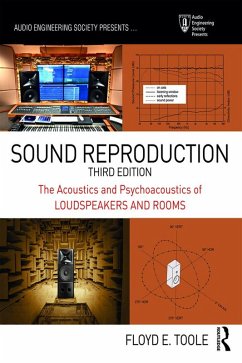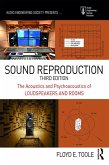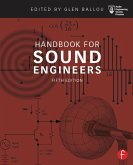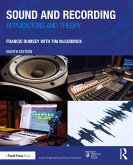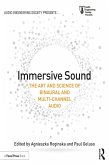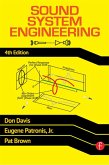Sound Reproduction (eBook, PDF)
The Acoustics and Psychoacoustics of Loudspeakers and Rooms


Alle Infos zum eBook verschenken

Sound Reproduction (eBook, PDF)
The Acoustics and Psychoacoustics of Loudspeakers and Rooms
- Format: PDF
- Merkliste
- Auf die Merkliste
- Bewerten Bewerten
- Teilen
- Produkt teilen
- Produkterinnerung
- Produkterinnerung

Hier können Sie sich einloggen

Bitte loggen Sie sich zunächst in Ihr Kundenkonto ein oder registrieren Sie sich bei bücher.de, um das eBook-Abo tolino select nutzen zu können.
Sound Reproduction: The Acoustics and Psychoacoustics of Loudspeakers and Rooms , Third Edition explains the physical and perceptual processes that are involved in sound reproduction and demonstrates how to use the processes to create high quality listening experiences in stereo and multichannel formats. Understanding the principles of sound production is necessary to achieve the goals of sound reproduction in spaces ranging from home listening rooms to large cinemas. This revision brings new science-based perspectives on the performance of loudspeakers, room acoustics, measurements, and equalization.…mehr
- Geräte: PC
- mit Kopierschutz
- eBook Hilfe
- Größe: 27.35MB
![Sound Reproduction (eBook, ePUB) Sound Reproduction (eBook, ePUB)]() Floyd TooleSound Reproduction (eBook, ePUB)63,95 €
Floyd TooleSound Reproduction (eBook, ePUB)63,95 €![Handbook for Sound Engineers (eBook, PDF) Handbook for Sound Engineers (eBook, PDF)]() Handbook for Sound Engineers (eBook, PDF)199,95 €
Handbook for Sound Engineers (eBook, PDF)199,95 €![Mixing with Impact (eBook, PDF) Mixing with Impact (eBook, PDF)]() Wessel OlthetenMixing with Impact (eBook, PDF)54,95 €
Wessel OlthetenMixing with Impact (eBook, PDF)54,95 €![Audio Engineering 101 (eBook, PDF) Audio Engineering 101 (eBook, PDF)]() Tim DittmarAudio Engineering 101 (eBook, PDF)41,95 €
Tim DittmarAudio Engineering 101 (eBook, PDF)41,95 €![Sound and Recording (eBook, PDF) Sound and Recording (eBook, PDF)]() Francis RumseySound and Recording (eBook, PDF)52,95 €
Francis RumseySound and Recording (eBook, PDF)52,95 €![Immersive Sound (eBook, PDF) Immersive Sound (eBook, PDF)]() Immersive Sound (eBook, PDF)91,95 €
Immersive Sound (eBook, PDF)91,95 €![Sound System Engineering 4e (eBook, PDF) Sound System Engineering 4e (eBook, PDF)]() Don DavisSound System Engineering 4e (eBook, PDF)142,95 €
Don DavisSound System Engineering 4e (eBook, PDF)142,95 €-
-
-
Dieser Download kann aus rechtlichen Gründen nur mit Rechnungsadresse in A, B, BG, CY, CZ, D, DK, EW, E, FIN, F, GR, HR, H, IRL, I, LT, L, LR, M, NL, PL, P, R, S, SLO, SK ausgeliefert werden.
- Produktdetails
- Verlag: Taylor & Francis eBooks
- Seitenzahl: 514
- Erscheinungstermin: 28. Juli 2017
- Englisch
- ISBN-13: 9781317415107
- Artikelnr.: 48959329
- Verlag: Taylor & Francis eBooks
- Seitenzahl: 514
- Erscheinungstermin: 28. Juli 2017
- Englisch
- ISBN-13: 9781317415107
- Artikelnr.: 48959329
- Herstellerkennzeichnung Die Herstellerinformationen sind derzeit nicht verfügbar.
Predicting Listener Preferences From Measurements 1. The Olive Experiments - Part One 2. The Olive Experiments - Part Two 3. The Olive Experiments - Part Three 27. Loudspeaker Resonances - Detection and Remedies 28. Summary and Discussion Chapter 6: Loudspeaker/Room Systems - an Introduction 1. One Room, Two Sound Fields - The Transition Frequency 2. A Brief History of Loudspeaker/Room Interactions 3. Timbral and Spatial Effects Attributable to Rooms Chapter 7: Above the Transition Frequency: Acoustical Events and Perceptions 29. The Physical Variables: Early Reflections 1. Problems with the Stereo Phantom Center Image 30. The Physical Variables: Loudspeaker Directivity 31. The Physical Variables: Acoustical Surface Treatments 1. Absorbers 2. Engineered Surfaces and Other Sound Scattering/Diffusing Devices 32. Subjective Evaluations of Physical Variations 1. Side Wall Treatment: Reflecting or Absorbing -Kishinaga et al. (1979) 2. The Effect of Loudspeaker Directivity - Toole (1985) 3. Loudspeaker Directivity and Wall Treatment Together - Choisel (2005) 4. The Nature of the Sound Field - Klippel (1990) 5. Observations of an Audio Enthusiast - Linkwitz (2007) 6. Observations of an Audio Enthusiast - Toole (2016) 7. Floor Reflections: A Special Case? 33. Professional vs. Recreational Listening 1. Hearing Loss is a Major Concern 2. Discussion 34. Perceptual Effects of Room Reflections 35. Adaptation and Perceptual Streaming 36. The Effect of Rooms on Loudspeaker Sound Quality 37. The Effect of Rooms on Speech Intelligibility 38. Sound Localization in Reflective Spaces
The Precedence (Haas) Effect 39. Bringing the Precedence Effect into the Real Acoustical World 1. Ceiling vs. Wall Reflections 2. Real vs. Phantom Images 3. Speech vs. Various Musical Sounds 40. Meaningful Measurements of Reflection Amplitudes Chapter 8: Below the Transition Frequency: Acoustical Events and Perceptions 41. The Basics of Room Resonances and Standing Waves 1. Optimizing Room Dimensions - Does an "Ideal" Room Exist? 2. Are Non-Rectangular Rooms the Answer? 42. Solutions for the Real World 1. Deliver Energy to the Modes and Dissipate Some of That Energy with Absorbers 2. Deliver Energy to the Modes and Reduce the Coupling of That Energy to the Listener By Optimizing the Listening Location - "Positional" Equalization 3. Reduce the Energy Delivered to a Bothersome Mode by Optimizing the Loudspeaker/Subwoofer Location 4. Reduce the Energy Delivered to a Bothersome Mode by Using Parametric Equalization 5. Reduce the Energy Delivered to a Bothersome Mode by Using Simple Mode-Manipulation Techniques 6. Selective Mode Activation in Rectangular Rooms Using Passive Multiple-Subwoofer Mode Manipulation 7. Mode Manipulation for Rectangular Rooms Using Multiple Subwoofers and Signal Processing 8. Mode Manipulation For Any Room Using Multiple Subwoofers and Signal Processing: Sound Field Management (SFM). 9. Revisiting Room Resonances in Time and Space 43. Do we Hear the Spectral Bump, the Temporal Ringing, or Both? 44. Stereo Bass: Little Ado About Even Less 45. Bass Management Makes it all Possible. 46. Summary and discussion Chapter 9: Adjacent boundary and loudspeaker mounting effects 47. The effects of solid angles on the radiation of sound by omnidirectional sources 48. Classic adjacent-boundary effects 1. Alleviating adjacent-boundary effects 49. Loudspeaker mounting options and effects 1. An example of adjacent-boundary interference 50. "Boundary-friendly" loudspeaker designs 51. Array loudspeakers - other ways to manipulate boundary interactions 52. Listeners also have boundaries Chapter 10: The Sound Fields in Sound Reproduction Spaces 53. Reverberation 1. Measuring reverberation time 2. Calculating reverberation time 3. Is there a more useful metric for our purposes? 54. Diffusion 55. Direct sound and early reflections 56. Near and far fields of rooms
sound level vs. distance 57. Near and far fields of sound sources 1. Point sources and real loudspeakers 2. Line sources 58. Air absorption at high frequencies 59. Screen loss in home theaters and cinemas 60. The directivities of common sound sources Chapter 11: Sound in cinemas 61. The closed loop of cinema sound 62. Sound fields in cinemas 1. A loudspeaker in a cinema 2. Adding a screen and applying the X-curve 63. The origins of the X-curve 64. A recent study adds confirmation and clarity 65. Flat, direct sound is an enduring favorite 66. Alternative targets - is it time to move on? 1. Compatibility with the rest of the audio world 2. Compatability with the cinema world 67. The effects of room size and seats 68. Cinema sound - where to next Chapter 12: Sound in home listening rooms, home theaters and recording control rooms 69. Good sound starts with good loudspeakers 1. Typical loudspeaker specifications - part of the problem 70. Loudspeakers in small rooms: the meaning of room curves 1. The effect of loudspeaker directional configuration 2. Looking back 42 years: the Møller/Brüel and Kjaer experiments 3. Room curves and equalization 71. Subjective preferences for sound spectra in listening rooms 72. Dialog intelligibility in home theaters 73. Recording control rooms 1. Old-school monitoring 2. Modern monitoring Chapter 13: A rational approach to designing, measuring and calibrating sound reproducing systems 74. Low frequencies - the universal problem 75. Sound above the transition frequency 1. Thirty years - some things change, some don't 2. The wrong room curve target? 3. "Room correction" and "room equalization" are misnomers. 4. Automotive audio 5. Headphones 6. Cinemas 76. Is there a common factor - a generalizable target? Chapter 14: Measurement methods 77. Alternative views of frequency response 1. Prediction of the direct sound and room curves from anechoic data 2. In-situ measurement of the direct sound 3. The steady-state room curve 78. Measures of loudness and system level calibrations. 1. Evaluating relative program loudness levels 2. Multichannel system level calibration 3. The effect of propagation distance - a side-channel challenge 79. Measurement microphones Chapter 15: Multichannel Audio 80. A few definitions 81. The birth of multichannel audio 82. Stereo - an important beginning 1. Loudspeakers as stereo image stabilizers 83. Quadraphonics - stereo times two 84. Multichannel audio - cinema to the rescue 85. Multichannel comes home 1. THX embellishments 86. How many loudspeakers and where? 1. Optimizing the delivery of "envelopment" 2. Summary 87. Surround system layouts 1. Loudspeaker directivity requirements 2. Mission oriented acoustical treatments 3. Surround loudspeaker options 88. The Ambisonics alternative 89. Upmixer manipulations: creative instincts at work 90. Multichannel audio goes digital, discrete and compressed 91. Three-dimensional sound - immersive audio 1. The perception of elevation Chapter 16: Loudspeakers and Power Amplifiers 1. Consequence of Loudspeaker Impedance Variations 2. The Damping Factor Deception 3. Loudspeaker Sensitivity Ratings and Power Amplifiers 4. The Audibility of Clipping Chapter 17: Hearing loss and hearing conservation 1. Occupational noise exposure limits 2. Non-occupational noise exposure 3. Binaural hearing is also affected 4. Some obsession can be a good thing Chapter 18: Fifty years of progress in loudspeaker design 92. My introduction to the real world 93. Two decades of domestic loudspeakers 94. Some early professional monitor loudspeakers 1. A "Toole" monitor loudspeaker 95. Looking around and looking ahead 96. The end References Index
Introduction
Chapter 1: Sound Production vs. Sound Reproduction
- Live Classical Musical Performances
- Live Popular Music Performances
- Reproduced Sound - The Audio Industry
- Preserving the Art - The Circle of Confusion
- Music and Movies - the State of Affairs
- The Role of Loudspeakers and Rooms
- Human Adaptation, a Reality the Cannot be Ignored
- Human Suggestibility
Chapter 2: A Scientific Perspective on Audio
- Requirements for Scientific Investigations
Chapter 3: Subjective Measurements - Turning Opinion into Fact
- Is Blind Listening Necessary?
- Hearing Ability and Listener Performance
- Stress and Strain
- How Many Channels?
- Controlling the Variables in Subjective Evaluations
- Controlling the Physical Variables
- The Listening Room - Making Tests Blind
- Real-time Loudspeaker Comparison Methods
- Binaural Record/Replay Loudspeaker Comparisons
- Listener Position and Seating
- Relative Loudness
- Absolute Loudness - Playback Sound Levels
- Choosing Program Material
- Power Amplifiers, Wire and So Forth
- Controlling the Psychological Variables
- How to do the Test
- Is it preference or accuracy that is evaluated?
- Chapter 4: The Perceptual and Physical Dimensions of Sound
- The Frequency Domain
- The Amplitude Domain
- Amplitude and Frequency Together: Frequency Response
- Amplitude and Frequency Together: Equal-Loudness Contours
- Loudness Controls and Tone Controls - Do They Work, Are They necessary?
- The Boundaries of What We Can Hear
- What Is Acceptable Background Noise?
- Linear Distortions: Amplitute and Phase vs. Frequency
- Spectral Tilt
- Resonances Viewed in Frequency and Time
- Finding and Fixing Resonances
- A Persistent Problem: Differentiating Between Evidence of Resonances and Acoustical Interference
- Critical bands, ERBNs, and the "resolution" of the hearing system
- Amplitude, Frequency and Time Together: Waterfall Diagrams
- Phase and Polarity - Do We Hear Waveforms?
- The Audibility of Phase Shift and Group Delay
- Phase Shift at Low Frequencies: a Special Case
- The Audibility of Absolute Polarity
- Non-Linear Distortions
- Wavelength, the Key to Understanding Much in Audio
- Loudspeaker Directivity
- Room Resonance Basics
- Resistive/Porous Absorbers and Membrane/Diaphragmatic Absorbers
- Diffusers and Other Sound Scattering Devices
Chapter 5: Characterizing Loudspeakers - Can We Describe What is Good?
- The Wisdom of the Ancients
- Identifying the Important Variables - What do we Measure?
- Anechoic Measurements - the Spinorama Evolves
- Total Sound Power as a Measured Parameter
- Why do we measure what we do? Are there better ways?
- Predicting Room curves From Anechoic Data - An Exercise in curve Matching.
- A Message About Sound Absorption and Scattering
- Why Do We Care About Room Curves?
- Closing the Loop - Predicting Listener Preferences From Measurements
- The Olive Experiments - Part One
- The Olive Experiments - Part Two
- The Olive Experiments - Part Three
- Loudspeaker Resonances - Detection and Remedies
- Summary and Discussion
Chapter 6: Loudspeaker/Room Systems - an Introduction
- One Room, Two Sound Fields - The Transition Frequency
- A Brief History of Loudspeaker/Room Interactions
- Timbral and Spatial Effects Attributable to Rooms
Chapter 7: Above the Transition Frequency: Acoustical Events and Perceptions
- The Physical Variables: Early Reflections
- Problems with the Stereo Phantom Center Image
- The Physical Variables: Loudspeaker Directivity
- The Physical Variables: Acoustical Surface Treatments
- Absorbers
- Engineered Surfaces and Other Sound Scattering/Diffusing Devices
- Subjective Evaluations of Physical Variations
- Side Wall Treatment: Reflecting or Absorbing -Kishinaga et al. (1979)
- The Effect of Loudspeaker Directivity - Toole (1985)
- Loudspeaker Directivity and Wall Treatment Together - Choisel (2005)
- The Nature of the Sound Field - Klippel (1990)
- Observations of an Audio Enthusiast - Linkwitz (2007)
- Observations of an Audio Enthusiast - Toole (2016)
- Floor Reflections: A Special Case?
- Professional vs. Recreational Listening
- Hearing Loss is a Major Concern
- Discussion
- Perceptual Effects of Room Reflections
- Adaptation and Perceptual Streaming
- The Effect of Rooms on Loudspeaker Sound Quality
- The Effect of Rooms on Speech Intelligibility
- Sound Localization in Reflective Spaces - The Precedence (Haas) Effect
- Bringing the Precedence Effect into the Real Acoustical World
- Ceiling vs. Wall Reflections
- Real vs. Phantom Images
- Speech vs. Various Musical Sounds
- Meaningful Measurements of Reflection Amplitudes
Chapter 8: Below the Transition Frequency: Acoustical Events and Perceptions
- The Basics of Room Resonances and Standing Waves
- Optimizing Room Dimensions - Does an "Ideal" Room Exist?
- Are Non-Rectangular Rooms the Answer?
- Solutions for the Real World
- Deliver Energy to the Modes and Dissipate Some of That Energy with Absorbers
- Deliver Energy to the Modes and Reduce the Coupling of That Energy to the Listener By Optimizing the Listening Location - "Positional" Equalization
- Reduce the Energy Delivered to a Bothersome Mode by Optimizing the Loudspeaker/Subwoofer Location
- Reduce the Energy Delivered to a Bothersome Mode by Using Parametric Equalization
- Reduce the Energy Delivered to a Bothersome Mode by Using Simple Mode-Manipulation Techniques
- Selective Mode Activation in Rectangular Rooms Using Passive Multiple-Subwoofer Mode Manipulation
- Mode Manipulation for Rectangular Rooms Using Multiple Subwoofers and Signal Processing
- Mode Manipulation For Any Room Using Multiple Subwoofers and Signal Processing: Sound Field Management (SFM).
- Revisiting Room Resonances in Time and Space
- Do we Hear the Spectral Bump, the Temporal Ringing, or Both?
- Stereo Bass: Little Ado About Even Less
- Bass Management Makes it all Possible.
- Summary and discussion
Chapter 9: Adjacent boundary and loudspeaker mounting effects
- The effects of solid angles on the radiation of sound by omnidirectional sources
- Classic adjacent-boundary effects
- Alleviating adjacent-boundary effects
- Loudspeaker mounting options and effects
- An example of adjacent-boundary interference
- "Boundary-friendly" loudspeaker designs
- Array loudspeakers - other ways to manipulate boundary interactions
- Listeners also have boundaries
Chapter 10: The Sound Fields in Sound Reproduction Spaces
- Reverberation
- Measuring reverberation time
- Calculating reverberation time
- Is there a more useful metric for our purposes?
- Diffusion
- Direct sound and early reflections
- Near and far fields of rooms - sound level vs. distance
- Near and far fields of sound sources
- Point sources and real loudspeakers
- Line sources
- Air absorption at high frequencies
- Screen loss in home theaters and cinemas
- The directivities of common sound sources
Chapter 11: Sound in cinemas
- The closed loop of cinema sound
- Sound fields in cinemas
- A loudspeaker in a cinema
- Adding a screen and applying the X-curve
- The origins of the X-curve
- A recent study adds confirmation and clarity
- Flat, direct sound is an enduring favorite
- Alternative targets - is it time to move on?
- Compatibility with the rest of the audio world
- Compatability with the cinema world
- The effects of room size and seats
- Cinema sound - where to next
Chapter 12: Sound in home listening rooms, home theaters and recording control rooms
- Good sound starts with good loudspeakers
- Typical loudspeaker specifications - part of the problem
- Loudspeakers in small rooms: the meaning of room curves
- The effect of loudspeaker directional configuration
- Looking back 42 years: the Møller/Brüel and Kjaer experiments
- Room curves and equalization
- Subjective preferences for sound spectra in listening rooms
- Dialog intelligibility in home theaters
- Recording control rooms
- Old-school monitoring
- Modern monitoring
Chapter 13: A rational approach to designing, measuring and calibrating sound reproducing systems
- Low frequencies - the universal problem
- Sound above the transition frequency
- Thirty years - some things change, some don't
- The wrong room curve target?
- "Room correction" and "room equalization" are misnomers.
- Automotive audio
- Headphones
- Cinemas
- Is there a common factor - a generalizable target?
Chapter 14: Measurement methods
- Alternative views of frequency response
- Prediction of the direct sound and room curves from anechoic data
- In-situ measurement of the direct sound
- The steady-state room curve
- Measures of loudness and system level calibrations.
- Evaluating relative program loudness levels
- Multichannel system level calibration
- The effect of propagation distance - a side-channel challenge
- Measurement microphones
Chapter 15: Multichannel Audio
- A few definitions
- The birth of multichannel audio
- Stereo - an important beginning
- Loudspeakers as stereo image stabilizers
- Quadraphonics - stereo times two
- Multichannel audio - cinema to the rescue
- Multichannel comes home
- THX embellishments
- How many loudspeakers and where?
- Optimizing the delivery of "envelopment"
- Summary
- Surround system layouts
- Loudspeaker directivity requirements
- Mission oriented acoustical treatments
- Surround loudspeaker options
- The Ambisonics alternative
- Upmixer manipulations: creative instincts at work
- Multichannel audio goes digital, discrete and compressed
- Three-dimensional sound - immersive audio
- The perception of elevation
Chapter 16: Loudspeakers and Power Amplifiers
- Consequence of Loudspeaker Impedance Variations
- The Damping Factor Deception
- Loudspeaker Sensitivity Ratings and Power Amplifiers
- The Audibility of Clipping
Chapter 17: Hearing loss and hearing conservation
- Occupational noise exposure limits
- Non-occupational noise exposure
- Binaural hearing is also affected
- Some obsession can be a good thing
Chapter 18: Fifty years of progress in loudspeaker design
- My introduction to the real world
- Two decades of domestic loudspeakers
- Some early professional monitor loudspeakers
- A "Toole" monitor loudspeaker
- Looking around and looking ahead
- The end
References
Index
Predicting Listener Preferences From Measurements 1. The Olive Experiments - Part One 2. The Olive Experiments - Part Two 3. The Olive Experiments - Part Three 27. Loudspeaker Resonances - Detection and Remedies 28. Summary and Discussion Chapter 6: Loudspeaker/Room Systems - an Introduction 1. One Room, Two Sound Fields - The Transition Frequency 2. A Brief History of Loudspeaker/Room Interactions 3. Timbral and Spatial Effects Attributable to Rooms Chapter 7: Above the Transition Frequency: Acoustical Events and Perceptions 29. The Physical Variables: Early Reflections 1. Problems with the Stereo Phantom Center Image 30. The Physical Variables: Loudspeaker Directivity 31. The Physical Variables: Acoustical Surface Treatments 1. Absorbers 2. Engineered Surfaces and Other Sound Scattering/Diffusing Devices 32. Subjective Evaluations of Physical Variations 1. Side Wall Treatment: Reflecting or Absorbing -Kishinaga et al. (1979) 2. The Effect of Loudspeaker Directivity - Toole (1985) 3. Loudspeaker Directivity and Wall Treatment Together - Choisel (2005) 4. The Nature of the Sound Field - Klippel (1990) 5. Observations of an Audio Enthusiast - Linkwitz (2007) 6. Observations of an Audio Enthusiast - Toole (2016) 7. Floor Reflections: A Special Case? 33. Professional vs. Recreational Listening 1. Hearing Loss is a Major Concern 2. Discussion 34. Perceptual Effects of Room Reflections 35. Adaptation and Perceptual Streaming 36. The Effect of Rooms on Loudspeaker Sound Quality 37. The Effect of Rooms on Speech Intelligibility 38. Sound Localization in Reflective Spaces
The Precedence (Haas) Effect 39. Bringing the Precedence Effect into the Real Acoustical World 1. Ceiling vs. Wall Reflections 2. Real vs. Phantom Images 3. Speech vs. Various Musical Sounds 40. Meaningful Measurements of Reflection Amplitudes Chapter 8: Below the Transition Frequency: Acoustical Events and Perceptions 41. The Basics of Room Resonances and Standing Waves 1. Optimizing Room Dimensions - Does an "Ideal" Room Exist? 2. Are Non-Rectangular Rooms the Answer? 42. Solutions for the Real World 1. Deliver Energy to the Modes and Dissipate Some of That Energy with Absorbers 2. Deliver Energy to the Modes and Reduce the Coupling of That Energy to the Listener By Optimizing the Listening Location - "Positional" Equalization 3. Reduce the Energy Delivered to a Bothersome Mode by Optimizing the Loudspeaker/Subwoofer Location 4. Reduce the Energy Delivered to a Bothersome Mode by Using Parametric Equalization 5. Reduce the Energy Delivered to a Bothersome Mode by Using Simple Mode-Manipulation Techniques 6. Selective Mode Activation in Rectangular Rooms Using Passive Multiple-Subwoofer Mode Manipulation 7. Mode Manipulation for Rectangular Rooms Using Multiple Subwoofers and Signal Processing 8. Mode Manipulation For Any Room Using Multiple Subwoofers and Signal Processing: Sound Field Management (SFM). 9. Revisiting Room Resonances in Time and Space 43. Do we Hear the Spectral Bump, the Temporal Ringing, or Both? 44. Stereo Bass: Little Ado About Even Less 45. Bass Management Makes it all Possible. 46. Summary and discussion Chapter 9: Adjacent boundary and loudspeaker mounting effects 47. The effects of solid angles on the radiation of sound by omnidirectional sources 48. Classic adjacent-boundary effects 1. Alleviating adjacent-boundary effects 49. Loudspeaker mounting options and effects 1. An example of adjacent-boundary interference 50. "Boundary-friendly" loudspeaker designs 51. Array loudspeakers - other ways to manipulate boundary interactions 52. Listeners also have boundaries Chapter 10: The Sound Fields in Sound Reproduction Spaces 53. Reverberation 1. Measuring reverberation time 2. Calculating reverberation time 3. Is there a more useful metric for our purposes? 54. Diffusion 55. Direct sound and early reflections 56. Near and far fields of rooms
sound level vs. distance 57. Near and far fields of sound sources 1. Point sources and real loudspeakers 2. Line sources 58. Air absorption at high frequencies 59. Screen loss in home theaters and cinemas 60. The directivities of common sound sources Chapter 11: Sound in cinemas 61. The closed loop of cinema sound 62. Sound fields in cinemas 1. A loudspeaker in a cinema 2. Adding a screen and applying the X-curve 63. The origins of the X-curve 64. A recent study adds confirmation and clarity 65. Flat, direct sound is an enduring favorite 66. Alternative targets - is it time to move on? 1. Compatibility with the rest of the audio world 2. Compatability with the cinema world 67. The effects of room size and seats 68. Cinema sound - where to next Chapter 12: Sound in home listening rooms, home theaters and recording control rooms 69. Good sound starts with good loudspeakers 1. Typical loudspeaker specifications - part of the problem 70. Loudspeakers in small rooms: the meaning of room curves 1. The effect of loudspeaker directional configuration 2. Looking back 42 years: the Møller/Brüel and Kjaer experiments 3. Room curves and equalization 71. Subjective preferences for sound spectra in listening rooms 72. Dialog intelligibility in home theaters 73. Recording control rooms 1. Old-school monitoring 2. Modern monitoring Chapter 13: A rational approach to designing, measuring and calibrating sound reproducing systems 74. Low frequencies - the universal problem 75. Sound above the transition frequency 1. Thirty years - some things change, some don't 2. The wrong room curve target? 3. "Room correction" and "room equalization" are misnomers. 4. Automotive audio 5. Headphones 6. Cinemas 76. Is there a common factor - a generalizable target? Chapter 14: Measurement methods 77. Alternative views of frequency response 1. Prediction of the direct sound and room curves from anechoic data 2. In-situ measurement of the direct sound 3. The steady-state room curve 78. Measures of loudness and system level calibrations. 1. Evaluating relative program loudness levels 2. Multichannel system level calibration 3. The effect of propagation distance - a side-channel challenge 79. Measurement microphones Chapter 15: Multichannel Audio 80. A few definitions 81. The birth of multichannel audio 82. Stereo - an important beginning 1. Loudspeakers as stereo image stabilizers 83. Quadraphonics - stereo times two 84. Multichannel audio - cinema to the rescue 85. Multichannel comes home 1. THX embellishments 86. How many loudspeakers and where? 1. Optimizing the delivery of "envelopment" 2. Summary 87. Surround system layouts 1. Loudspeaker directivity requirements 2. Mission oriented acoustical treatments 3. Surround loudspeaker options 88. The Ambisonics alternative 89. Upmixer manipulations: creative instincts at work 90. Multichannel audio goes digital, discrete and compressed 91. Three-dimensional sound - immersive audio 1. The perception of elevation Chapter 16: Loudspeakers and Power Amplifiers 1. Consequence of Loudspeaker Impedance Variations 2. The Damping Factor Deception 3. Loudspeaker Sensitivity Ratings and Power Amplifiers 4. The Audibility of Clipping Chapter 17: Hearing loss and hearing conservation 1. Occupational noise exposure limits 2. Non-occupational noise exposure 3. Binaural hearing is also affected 4. Some obsession can be a good thing Chapter 18: Fifty years of progress in loudspeaker design 92. My introduction to the real world 93. Two decades of domestic loudspeakers 94. Some early professional monitor loudspeakers 1. A "Toole" monitor loudspeaker 95. Looking around and looking ahead 96. The end References Index
Introduction
Chapter 1: Sound Production vs. Sound Reproduction
- Live Classical Musical Performances
- Live Popular Music Performances
- Reproduced Sound - The Audio Industry
- Preserving the Art - The Circle of Confusion
- Music and Movies - the State of Affairs
- The Role of Loudspeakers and Rooms
- Human Adaptation, a Reality the Cannot be Ignored
- Human Suggestibility
Chapter 2: A Scientific Perspective on Audio
- Requirements for Scientific Investigations
Chapter 3: Subjective Measurements - Turning Opinion into Fact
- Is Blind Listening Necessary?
- Hearing Ability and Listener Performance
- Stress and Strain
- How Many Channels?
- Controlling the Variables in Subjective Evaluations
- Controlling the Physical Variables
- The Listening Room - Making Tests Blind
- Real-time Loudspeaker Comparison Methods
- Binaural Record/Replay Loudspeaker Comparisons
- Listener Position and Seating
- Relative Loudness
- Absolute Loudness - Playback Sound Levels
- Choosing Program Material
- Power Amplifiers, Wire and So Forth
- Controlling the Psychological Variables
- How to do the Test
- Is it preference or accuracy that is evaluated?
- Chapter 4: The Perceptual and Physical Dimensions of Sound
- The Frequency Domain
- The Amplitude Domain
- Amplitude and Frequency Together: Frequency Response
- Amplitude and Frequency Together: Equal-Loudness Contours
- Loudness Controls and Tone Controls - Do They Work, Are They necessary?
- The Boundaries of What We Can Hear
- What Is Acceptable Background Noise?
- Linear Distortions: Amplitute and Phase vs. Frequency
- Spectral Tilt
- Resonances Viewed in Frequency and Time
- Finding and Fixing Resonances
- A Persistent Problem: Differentiating Between Evidence of Resonances and Acoustical Interference
- Critical bands, ERBNs, and the "resolution" of the hearing system
- Amplitude, Frequency and Time Together: Waterfall Diagrams
- Phase and Polarity - Do We Hear Waveforms?
- The Audibility of Phase Shift and Group Delay
- Phase Shift at Low Frequencies: a Special Case
- The Audibility of Absolute Polarity
- Non-Linear Distortions
- Wavelength, the Key to Understanding Much in Audio
- Loudspeaker Directivity
- Room Resonance Basics
- Resistive/Porous Absorbers and Membrane/Diaphragmatic Absorbers
- Diffusers and Other Sound Scattering Devices
Chapter 5: Characterizing Loudspeakers - Can We Describe What is Good?
- The Wisdom of the Ancients
- Identifying the Important Variables - What do we Measure?
- Anechoic Measurements - the Spinorama Evolves
- Total Sound Power as a Measured Parameter
- Why do we measure what we do? Are there better ways?
- Predicting Room curves From Anechoic Data - An Exercise in curve Matching.
- A Message About Sound Absorption and Scattering
- Why Do We Care About Room Curves?
- Closing the Loop - Predicting Listener Preferences From Measurements
- The Olive Experiments - Part One
- The Olive Experiments - Part Two
- The Olive Experiments - Part Three
- Loudspeaker Resonances - Detection and Remedies
- Summary and Discussion
Chapter 6: Loudspeaker/Room Systems - an Introduction
- One Room, Two Sound Fields - The Transition Frequency
- A Brief History of Loudspeaker/Room Interactions
- Timbral and Spatial Effects Attributable to Rooms
Chapter 7: Above the Transition Frequency: Acoustical Events and Perceptions
- The Physical Variables: Early Reflections
- Problems with the Stereo Phantom Center Image
- The Physical Variables: Loudspeaker Directivity
- The Physical Variables: Acoustical Surface Treatments
- Absorbers
- Engineered Surfaces and Other Sound Scattering/Diffusing Devices
- Subjective Evaluations of Physical Variations
- Side Wall Treatment: Reflecting or Absorbing -Kishinaga et al. (1979)
- The Effect of Loudspeaker Directivity - Toole (1985)
- Loudspeaker Directivity and Wall Treatment Together - Choisel (2005)
- The Nature of the Sound Field - Klippel (1990)
- Observations of an Audio Enthusiast - Linkwitz (2007)
- Observations of an Audio Enthusiast - Toole (2016)
- Floor Reflections: A Special Case?
- Professional vs. Recreational Listening
- Hearing Loss is a Major Concern
- Discussion
- Perceptual Effects of Room Reflections
- Adaptation and Perceptual Streaming
- The Effect of Rooms on Loudspeaker Sound Quality
- The Effect of Rooms on Speech Intelligibility
- Sound Localization in Reflective Spaces - The Precedence (Haas) Effect
- Bringing the Precedence Effect into the Real Acoustical World
- Ceiling vs. Wall Reflections
- Real vs. Phantom Images
- Speech vs. Various Musical Sounds
- Meaningful Measurements of Reflection Amplitudes
Chapter 8: Below the Transition Frequency: Acoustical Events and Perceptions
- The Basics of Room Resonances and Standing Waves
- Optimizing Room Dimensions - Does an "Ideal" Room Exist?
- Are Non-Rectangular Rooms the Answer?
- Solutions for the Real World
- Deliver Energy to the Modes and Dissipate Some of That Energy with Absorbers
- Deliver Energy to the Modes and Reduce the Coupling of That Energy to the Listener By Optimizing the Listening Location - "Positional" Equalization
- Reduce the Energy Delivered to a Bothersome Mode by Optimizing the Loudspeaker/Subwoofer Location
- Reduce the Energy Delivered to a Bothersome Mode by Using Parametric Equalization
- Reduce the Energy Delivered to a Bothersome Mode by Using Simple Mode-Manipulation Techniques
- Selective Mode Activation in Rectangular Rooms Using Passive Multiple-Subwoofer Mode Manipulation
- Mode Manipulation for Rectangular Rooms Using Multiple Subwoofers and Signal Processing
- Mode Manipulation For Any Room Using Multiple Subwoofers and Signal Processing: Sound Field Management (SFM).
- Revisiting Room Resonances in Time and Space
- Do we Hear the Spectral Bump, the Temporal Ringing, or Both?
- Stereo Bass: Little Ado About Even Less
- Bass Management Makes it all Possible.
- Summary and discussion
Chapter 9: Adjacent boundary and loudspeaker mounting effects
- The effects of solid angles on the radiation of sound by omnidirectional sources
- Classic adjacent-boundary effects
- Alleviating adjacent-boundary effects
- Loudspeaker mounting options and effects
- An example of adjacent-boundary interference
- "Boundary-friendly" loudspeaker designs
- Array loudspeakers - other ways to manipulate boundary interactions
- Listeners also have boundaries
Chapter 10: The Sound Fields in Sound Reproduction Spaces
- Reverberation
- Measuring reverberation time
- Calculating reverberation time
- Is there a more useful metric for our purposes?
- Diffusion
- Direct sound and early reflections
- Near and far fields of rooms - sound level vs. distance
- Near and far fields of sound sources
- Point sources and real loudspeakers
- Line sources
- Air absorption at high frequencies
- Screen loss in home theaters and cinemas
- The directivities of common sound sources
Chapter 11: Sound in cinemas
- The closed loop of cinema sound
- Sound fields in cinemas
- A loudspeaker in a cinema
- Adding a screen and applying the X-curve
- The origins of the X-curve
- A recent study adds confirmation and clarity
- Flat, direct sound is an enduring favorite
- Alternative targets - is it time to move on?
- Compatibility with the rest of the audio world
- Compatability with the cinema world
- The effects of room size and seats
- Cinema sound - where to next
Chapter 12: Sound in home listening rooms, home theaters and recording control rooms
- Good sound starts with good loudspeakers
- Typical loudspeaker specifications - part of the problem
- Loudspeakers in small rooms: the meaning of room curves
- The effect of loudspeaker directional configuration
- Looking back 42 years: the Møller/Brüel and Kjaer experiments
- Room curves and equalization
- Subjective preferences for sound spectra in listening rooms
- Dialog intelligibility in home theaters
- Recording control rooms
- Old-school monitoring
- Modern monitoring
Chapter 13: A rational approach to designing, measuring and calibrating sound reproducing systems
- Low frequencies - the universal problem
- Sound above the transition frequency
- Thirty years - some things change, some don't
- The wrong room curve target?
- "Room correction" and "room equalization" are misnomers.
- Automotive audio
- Headphones
- Cinemas
- Is there a common factor - a generalizable target?
Chapter 14: Measurement methods
- Alternative views of frequency response
- Prediction of the direct sound and room curves from anechoic data
- In-situ measurement of the direct sound
- The steady-state room curve
- Measures of loudness and system level calibrations.
- Evaluating relative program loudness levels
- Multichannel system level calibration
- The effect of propagation distance - a side-channel challenge
- Measurement microphones
Chapter 15: Multichannel Audio
- A few definitions
- The birth of multichannel audio
- Stereo - an important beginning
- Loudspeakers as stereo image stabilizers
- Quadraphonics - stereo times two
- Multichannel audio - cinema to the rescue
- Multichannel comes home
- THX embellishments
- How many loudspeakers and where?
- Optimizing the delivery of "envelopment"
- Summary
- Surround system layouts
- Loudspeaker directivity requirements
- Mission oriented acoustical treatments
- Surround loudspeaker options
- The Ambisonics alternative
- Upmixer manipulations: creative instincts at work
- Multichannel audio goes digital, discrete and compressed
- Three-dimensional sound - immersive audio
- The perception of elevation
Chapter 16: Loudspeakers and Power Amplifiers
- Consequence of Loudspeaker Impedance Variations
- The Damping Factor Deception
- Loudspeaker Sensitivity Ratings and Power Amplifiers
- The Audibility of Clipping
Chapter 17: Hearing loss and hearing conservation
- Occupational noise exposure limits
- Non-occupational noise exposure
- Binaural hearing is also affected
- Some obsession can be a good thing
Chapter 18: Fifty years of progress in loudspeaker design
- My introduction to the real world
- Two decades of domestic loudspeakers
- Some early professional monitor loudspeakers
- A "Toole" monitor loudspeaker
- Looking around and looking ahead
- The end
References
Index
